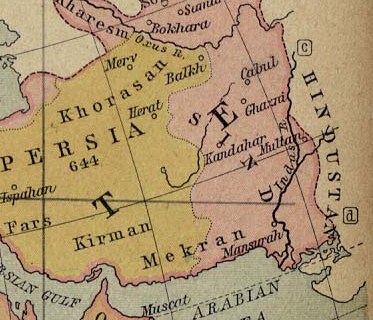Datoteka:Ancient Khorasan highlighted.jpg
Ancient_Khorasan_highlighted.jpg ((373 × 320 piksela, veličina datoteke: 58 KB, <a href="/wiki/MIME" title="MIME">MIME</a> tip: image/jpeg))
| Ova je datoteka sa stranica Zajedničkog poslužitelja Zaklade Wikimedije i smiju je rabiti drugi projekti. Opis s njezine stranice s opisom datoteke prikazan je ispod. |
| OpisAncient Khorasan highlighted.jpg |
Map showing Ancient Persia in light yellowish and the the land called Sind (most of today's Afghanistan and part of Pakistan) in pinkish. A number of ancient references are made to the names shown in this map. Ibn Batutta writes in 1333 AD: [1]
|
|||||
| Datum | ||||||
| Izvor | University of Texas at Austin, Middle East and Europe - The Caliphate in 750 (293K) | |||||
| Autor | William R. Shepherd | |||||
| Dopuštenje (Naknadna uporaba ove datoteke) |
|
|||||
| Ostale inačice | full version: File:Califate 750.jpg | |||||
Opisi
Predmeti prikazani u ovoj datoteci
motiv
William Robert Shepherd engleski
1926
image/jpeg
checksum engleski
18a4d90f811c5cd49f824d42f0a27bbb22790c6a
data size engleski
59.539 Bajt
320 točka
373 točka
Povijest datoteke
Kliknite na datum/vrijeme kako biste vidjeli datoteku kakva je tada bila.
| Datum/Vrijeme | Minijatura | Dimenzije | Suradnik | Komentar | |
|---|---|---|---|---|---|
| sadašnja | 19:07, 22. listopada 2010. |  | 373 × 320 (58 KB) | Officer | {{Information |Description= |Source= |Date= |Author= |Permission= |other_versions= }} |
Poveznice
Na ovu sliku vode poveznice sa sljedećih stranica:
Metapodatci
Ova datoteka sadržava dodatne podatke koje je vjerojatno dodala digitalna kamera ili skener u procesu snimanja odnosno digitalizacije. Ako je datoteka mijenjana, podatci možda nisu u skladu sa stvarnim stanjem.
| Orijentacija kadra | Normalno |
|---|---|
| Datum posljednje promjene datoteke | 00:05, 23. listopada 2010. |
| Jedinstveni identifikator slike | B6DFF879490640F9B66D893D7007EC6F |
